Stephen Morris's Blog, page 12
June 28, 2021
The Lamb and the 144,000
 Page from a famous illuminated manuscript painted by an unknown artist, depicting the 144,000 from Revelation 7, from a copy of the Commentary on the Apocalypse by Saint Beatus of Liébana
Page from a famous illuminated manuscript painted by an unknown artist, depicting the 144,000 from Revelation 7, from a copy of the Commentary on the Apocalypse by Saint Beatus of Liébana Then I looked, and there before me was the Lamb, standing on Mount Zion, and with him 144,000 who had his name and his Father’s name written on their foreheads. And I heard a sound from heaven like the roar of rushing waters and like a loud peal of thunder. The sound I heard was like that of harpists playing their harps. And they sang a new song before the throne and before the four living creatures and the elders. No one could learn the song except the 144,000 who had been redeemed from the earth. (Apocalypse 14:1-3)
SO much to say about such a brief passage! Modern commentaries often claim that the 144,000 are the Messianic Jews who accept that Jesus is the Messiah but in the early Church there was no such distinction between ethnic Jews and Gentile Christians. Classic commentaries by church Fathers interpret the 144,000 as emblematic of the perfected Church–12x12x1000 being the 12 apostles x 12 tribes of Israel x 1000 (perfection). That is also why the 1,000 year reign of Christ is an emblem of history perfected, not a literal 1,000 years as we know the cycle of 365 days x 1000.
The new song of the new day of salvation grows out of the song of deliverance sung by Israel on the shore of the Red Sea after the Exodus. (Have I told y’all about this already? I think I have.) The new song is also the Sanctus (“Holy! Holy! Holy!”) sung by the angels as they stand around the Throne of God and which we join them singing during the celebration of the Eucharist. During the Eucharist, we stand with the 144,000 before the Throne–together with the elders (presbyters) and four living creatures; together, we sing the Sanctus and give thanks for all that the Holy Trinity have done for us.
The saved are marked with the name of the Lamb and his Father, just as the followers of the Beast are marked by the diabolic number. But the classic commentary on the Apocalypse by Tyconius has something very different to say: according to Tyconius, the diabolic mark of the Beast is not described in Chapter 13. Rather, the number at the end of Chapter 13 is “616” and is “the number of a [certain] man,” i.e. the Son of Man, the Lamb of God. The number 616 is the total of alpha and omega, the first and last letters of the Greek alphabet and refer to Christ. It is also the total of the letters XIS, the first and last letters of “Christ Jesus.” Therefore, Tyconius understands the numbers 616 to indicate the famous Chi Rho emblem of Christianity. It is this emblem which is described as marked on the 144,000 at the beginning of Chapter 14.
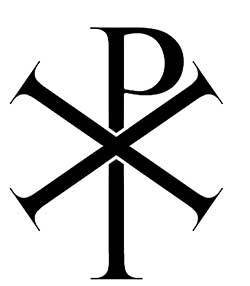
Other early commentators say that the sign marked on the 144,000 is the cross drawn in chrism-oil by the bishop with his thumb when converts were baptized.
How’s that for a totally unexpected set of ideas about the 666 that we discussed last week?!
The post The Lamb and the 144,000 appeared first on Stephen Morris, author.
June 22, 2021
666 is the Number of the Beast
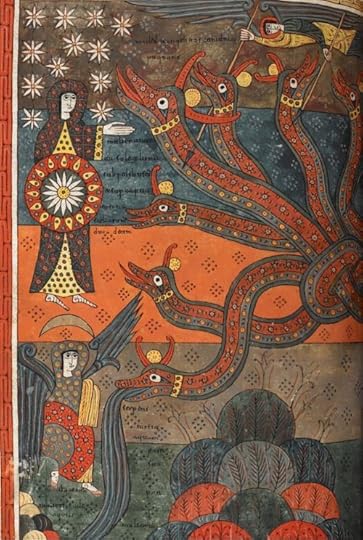 Dragons and beasts abound in the Apocalypse and always attack the Church in some way, whether by martyrdom or financial and economic constraints. The number 666–which is used to impinge on Christian economic activity—has been interpreted in a variety of ways.
Dragons and beasts abound in the Apocalypse and always attack the Church in some way, whether by martyrdom or financial and economic constraints. The number 666–which is used to impinge on Christian economic activity—has been interpreted in a variety of ways.Then I saw another beast rising out of the land; it had two horns like a lamb’s but spoke like a dragon…. This calls for wisdom. Let anyone who has intelligence figure out the number of the beast for it is the number of a human being; and it’s number is six hundred and sixty-six. (Apocalypse 13:11, 18)
“This calls for wisdom.” That’s probably one of the greatest understatements ever! The debate about the identity of the Beast and the meaning of the number 666 is ongoing and seemingly endlessly fascinating.
One beast arises from the sea. Another beast arises from the land. The sea monster Leviathan and the land-monster Behemoth are a team, symbolic of a nation-state or political system-regime intent on destroying the Church. Some preachers say that the first beast is the political system that wants to destroy the Church while the second, land-based monster is the religious opposition to the Church: it is a mockery of the Lamb as it attempts a masquerade, looking like the Lamb but speaking with the voice of the dragon who attacked the woman clothed with the sun.
The land-monster causes all the people under the dominion of the first beast to “have a mark put on the right hand or on the forehead and no one was allowed to buy or sell unless one had the mark, the name of the beast or the number of its name.” (Apoc. 13:16-17) In order to participate in economic and social life, people had to be marked with the number or the name of the beast–the beast commonly identified as Nero as the numeric value of the letters in his name add up to the infamous “666.” This mark is an official stamp. Perhaps a tattoo. Certainly a travesty of the sign of the cross marked with chrism on the hands and forehead of the newly baptized.
Some modern evangelicals say “the mark of the beast” is a certain credit card or identification card. In the ancient and medieval world, membership in business guilds was an important–sometimes necessary–aspect of economic life and in the Roman world such guilds often expected members to participate in pagan religious rites. Ancient commentaries say the mark of the beast were the coins issued by the emperor with his image on them. If the early Christians could not use coins in the market, they would be effectively marginalized and exiled to rural communes where they lived “off the grid” and supplied all their own goods. But that was just as highly unlikely to be a functional way to live in the first century AD as it is in the twenty-first century AD.
How to navigate the demands of mainstream culture is a constant question in the Church, even if that mainstream culture has been formed in large measure by the Church–the most superficial study reveals that Byzantium or Holy Russia or Christian Europe were societies that often opposed the most basic Christian teachings and practices. The most overtly Christian regimes were often the most oppressive, rigid, and cruel. How to avoid receiving the mark of the beast today?
The post 666 is the Number of the Beast appeared first on Stephen Morris, author.
June 14, 2021
St. Michael and the Dragon: Victory in Heaven
 The war in heaven depicted in “Las Huelgas Apocalypse,” Spain AD 1220; the commentary of Beatus of Liebana.
The war in heaven depicted in “Las Huelgas Apocalypse,” Spain AD 1220; the commentary of Beatus of Liebana.Then war broke out in heaven. Michael and his angels fought against the dragon. The dragon and his angels fought back and he did not prevail…. The great dragon was thrown down, that ancient serpent who is called Devil and Satan, the deceiver of the whole world…. (Apocalypse 12:7-9)
The Archangel Michael (Jude 9) is the captain of God’s armies and the champion of the Chosen People (Daniel 10:21, 12:1); in the Old Testament, he is the most powerful figure, second only to God. Although Satan does occasionally appear in heaven (Job 1), he is definitively cast down and overthrown here.
The dragon is identified both with the serpent who tempted Eve and with the adversary, the accuser who demanded that God allow him to test the sincerity of both Job and the Apostle Peter (Luke 22:31). Satan wanted to ruin them both but did not succeed. Satan, the dragon, wants to ruin the human race. He wants to ruin the entire creation. His jealousy goads him to want to destroy everything (Wisdom 1-2) but in the end, his jealousy destroys only himself.
Often the spear that St. Michael uses to fight the dragon with is a wooden lance; it is by the wood of the Cross that the dragon is overthrown. The archangel Michael’s victory is the heavenly and symbolic counterpart of Jesus hanging-dying on the Cross. The martyrs, as members of the Body of Christ, who testify-witness about the victory of the Cross, share in this victory but the victory is demonstrated by their dying as Christ died on the Cross. The events described in chapter 12 of the Apocalypse—the woman clothed with the sun, the dragon, the war in heaven—are the central events of the Apocalypse, around which everything else revolves, because they are the representation of the central events of earthly history.
“I saw Satan fall like lightning from heaven,” says Jesus (Luke 10:18); therefore the apostles are able to cast out devils who possess humans. The Lamb, “who was slain from the foundation of the world,” is both eternally the victor and the one who wins the victory at a particular time-place in the world. Both the eternal victory and the victory in time are true; neither victory cancels or outweighs the other.
The dragon is not simply THE Devil, a single angelic personality. The dragon is all the enemies of God at once; in Ezekiel 29:3 and 32:2-3, we read that the Pharaoh of the Exodus is “like a dragon in the sea,” a great water monster who attempts to devour the Chosen People. The dragon is the Roman system which attempts to eradicate the Church. The dragon is everything and everyone who attempts to deny the victory of the Cross.
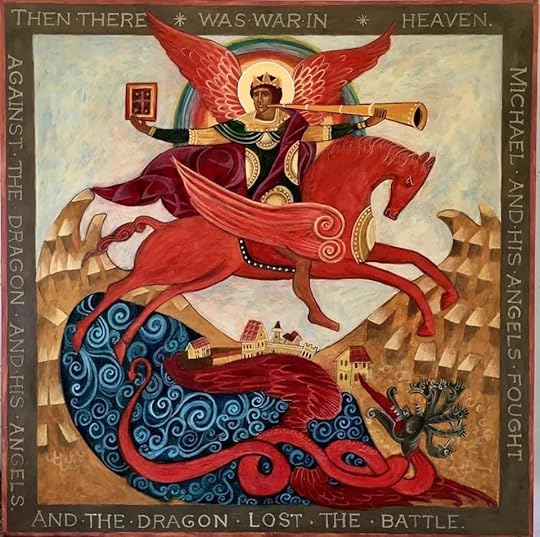
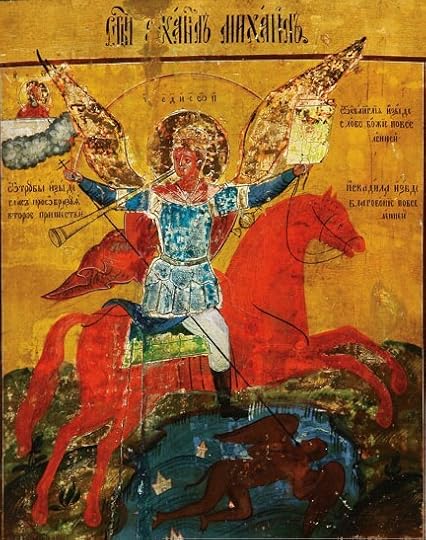
The post St. Michael and the Dragon: Victory in Heaven appeared first on Stephen Morris, author.
June 7, 2021
Woman Clothed With the Sun
 The woman clothed with the sun attacked by the seven-headed red dragon depicted in a 17th-century fresco in a Mt. Athos monastery.
The woman clothed with the sun attacked by the seven-headed red dragon depicted in a 17th-century fresco in a Mt. Athos monastery.A great sign appeared in heaven: a woman robed with the sun, with the moon under her feet, and a crown of twelve stars on her head. She was with child and she cried out in her pangs of birth …. Then a second sign appeared in heaven: a great red dragon with seven heads …. (Apocalypse 12:1-6)
The woman clothed with the sun is one of my favorite characters or episodes in the New Testament. In the earliest commentaries, she is understood to be the Church, the New Israel, and the baby she gives birth to is the new Christian–at this period, typically an adult–who emerges newborn from the baptismal font. The red dragon with seven heads is the Roman imperial system who attacks the Church and slays the martyrs. The woman and her baby–the Church and the newly baptized–escape to safety in the wilderness, which is where the early ascetics and first monastics fled to pray and fast.
One of my favorite patristic texts–one of the first I ever read in its totality, as a freshman in the Sterling Library at Yale–is The Banquet by St. Methodius of Olympus. The Banquet is the one of the first and is the most extensive of the early Christian discussions of the woman clothed with the sun.
In the third century, commentators begin to see the woman clothed with the sun as the ever-virgin Mother of God who gives birth to Christ. They are attacked by Herod and flee to safety in Egypt. The importance of this interpretation of the Mother of God grows in importance as she becomes a model for the ascetics and monastics in the desert-wilderness, usually in Egypt but also near the Jordan River.
The image of the woman clothed with the sun becomes associated with the “falling asleep” (the Dormition or Assumption) of the Mother of God. She is taken into eternal glory in the Kingdom of God because she is the Mother of God who gives her flesh to the Word. Everything human about the Word-made-flesh came from her; his DNA is her DNA. She is the first believer to be taken into glory as a pledge of what all members of the Body of Christ will experience.
The woman clothed with the sun is one of the most frequently depicted figures in the New Testament. If the Apocalypse is a multi-valent and many layered text, the woman clothed with the sun is one of the most multi-valent and many layered figures in the New Testament.
 The woman clothed with the sun in an illumination from the Beatus manuscript of the Apocalypse.
The woman clothed with the sun in an illumination from the Beatus manuscript of the Apocalypse. Another medieval manuscript illumination depicting the woman clothed with the sun escaping from the great dragon.
Another medieval manuscript illumination depicting the woman clothed with the sun escaping from the great dragon.The post Woman Clothed With the Sun appeared first on Stephen Morris, author.
June 1, 2021
Two Witnesses
 The two witnesses of Apocalypse 11, about to be attacked by the beast from the abyss. They are standing before the Temple, described earlier in chapter 11; the witnesses are identified by the names “Enoch” and “Moses” above their heads.
The two witnesses of Apocalypse 11, about to be attacked by the beast from the abyss. They are standing before the Temple, described earlier in chapter 11; the witnesses are identified by the names “Enoch” and “Moses” above their heads.I will commission my two witnesses to prophesy for those 1,260 days, dressed in sackcloth. These are the two olive-trees and the two lamps that stand before the Lord of the earth…. But when they have completed their testimony, the beast that comes up from the abyss will wage war on them and overcome them and kill them. (Apocalypse 11:3-4, 7)
The two witnesses–lit. martyrs–are spokesmen for God that are killed by the powers that oppose God. Their corpses will remain in the streets to be mocked and defiled but they will be raised from the dead and ascend into heaven. The murder of the two witnesses is the second of the “three woes” that are expected (Apoc. 9).
The witnesses are dressed as prophets, in sackcloth, and preach for more than a thousand days (the symbolic length of history). They are compared to the king Zerubbabel and the high priest Joshua (Zech. 2 and 4). Some authors thought the two witnesses would be Moses and Elijah (who was taken into heaven without dying), come to proclaim the judgement of God; frequently others think the two witnesses will be Moses and Enoch (who was also taken into heaven without dying).
The beast from the abyss slays the witnesses after they have been preaching for 1,000+ days. Later in the Apocalypse, we read the same story from another perspective: “When the 1,000 years are ended, Satan will be let loose from his prison and he will come out to deceive the nations” (Apoc. 20:7-8). We also read the same story from another perspective in the next chapter of the Apocalypse when the dragon attacks the woman clothed with the sun–one of my favorite episodes in the New Testament!
Repeatedly in the Gospel and throughout the history of the Church, the devil and the powers of Death that rebel against God attack and seem to triumph but are finally overthrown and defeated. This is the most basic message of the Apocalypse: the Enemy will seem to triumph but–take heart!–can never win the final victory.
The post Two Witnesses appeared first on Stephen Morris, author.
May 24, 2021
A Little Scroll
 This fresco on Mt. Athos from the 17th century depicts the opening of chapter 10 of the Apocalypse: St. John sees the massive angel, standing with a foot in the sea and a foot on land, who gives him a little scroll to eat.
This fresco on Mt. Athos from the 17th century depicts the opening of chapter 10 of the Apocalypse: St. John sees the massive angel, standing with a foot in the sea and a foot on land, who gives him a little scroll to eat.Then I saw another mighty angel coming down from heaven, wrapped in a cloud, with a rainbow over his head: his face was like the sun and his legs like pillars of fire. He held in his hand a little scroll which was open…. He said to me, “take it and eat it.” (Apocalypse 10:1-2, 9)
St. John takes the small, open scroll and eats it although the angel warns that it will taste sweet in his mouth and then turn his stomach sour. “You must prophesy over many peoples and nations and tongues and kings,” St. John is told after eating the scroll.
Eating a scroll is often the first thing a prophet is told to do (Ezekiel 3). The prophet ingests the message he is to deliver and integrates it into himself. It becomes his message as well as the message of God. (The scroll that Ezekiel eats is also sweet to taste but produces “laments and words of woe.” Both Ezekiel and the Apocalypse are associated with the liturgical season of Eastertide; the Death and Resurrection of Christ are simultaneously blessing and judgement which are described in terms of the Last Days by the prophet and the apostle.)
Given that the Apocalypse is a liturgical commentary, what does this episode correspond to in the Eucharist? Consuming the little scroll can also correspond with receiving Holy Communion, as does Isaiah’s lips being touched by a heavenly coal. Each communicant is called to the same vocation as the seer although details of how that vocation is exercised may differ.
Although this scroll is small, unlike the others mentioned in the Apocalypse, its most important distinguishing feature is that it is open rather than closed. An open message is one that will be fulfilled shortly after it is proclaimed; a closed message is about an event that will happen long after the proclamation is made. The message that will be accomplished soon is the preaching of the Gospel to “many peoples and nations and tongues and kings.” Prophets like Ezekiel were sent only to the Israelites; John–and the Church as a whole–are sent to the whole world. The ingathering of the nations to join Israel in receiving the blessings of God was proclaimed by the prophets as one of the signs that the Last Days had finally come; the nations responding to the preaching of the Gospel is a sign that the Last Days have now arrived.
The Apocalypse is, in many ways, the proclamation of the same message that the prophets proclaimed but that message has now been fulfilled-accomplished. The Last Judgement–while still a distant event in linear time–has begun and is already present in the spiritual-liturgical life of the Church. Eternity has begun to erupt into the world of space-time. The Apocalypse is not a blueprint or a timeline for something to happen in the future; it describes the life of the Church now.
The fancy theological way to refer to this is “realized eschatology.” Eschatology is the Greek word for “last things.” The last things have been realized/accomplished in the life-ministry-Passion of Christ and are now playing out in the life of the Church. Sometimes “realized eschatology” is contrasted with consistent eschatology, which insists that the Last Days are still entirely in the future. The two concepts are combined by some modern authors in inaugurated eschatology.
The post A Little Scroll appeared first on Stephen Morris, author.
May 17, 2021
Shaft of the Abyss
I saw a star fallen from heaven to earth, and he was given a key to the shaft of the abyss. He opened the shaft of the abyss, and smoke came up from the shaft like smoke from a great furnace, and the sun and the air were darkened by the smoke from the shaft. Out of the smoke came locusts… (Apoc. 9:1-3)
A fallen star is a fallen angel. Hence, the star is “he” and given a key to the abyss. Stars–in apocalyptic writing–are always angels, whether good or bad, faithful to God or not. The tradition of fallen angels is ancient though it does not appear in the oldest layer of biblical writing; the story of the angelic fall is told in 1 Enoch 6-13, an expansion of Genesis 6:1-4. Jesus also refers to the fall of the angels: “I saw Satan fall like lightning from heaven” (Luke 10:18).
The “abyss” is the usual Greek translation of “the deep” (ex. Gen. 1:2, Psalm 105:9, 107:26); it is also used to refer to Sheol (Job 41, Romans 10). In the Apocalypse, the abyss-the deep-sheol is the provisional prison of Satan and the fallen angels. In the gospel, the demons beg Jesus not to send them there (Luke 8:31). In this chapter of the Apocalypse, a shaft leads to the abyss-the deep-sheol and a fallen angel is allowed to unlock it.
Out of the abyss comes a great cloud of smoke and ash; from the smoke and ash come the monstrous locusts that attack people but are not allowed to attack the earth itself, unlike natural locusts. These supernatural locusts attack and torture but cannot kill; they can sting like scorpions and have a king (the word is more usually translated as “emperor”), unlike natural locusts (Proverbs 30:27).
Is the Apocalypse comparing the locusts to the imperial Roman system by using the Greek word for “emperor” rather than “king” to describe their organization? If so, then the Roman state–and any political system that is in opposition to God–can attack and torment the faithful but cannot destroy or overwhelm the Kingdom of God. I have recently discovered the work of Walter Wink, who writes about the demonic aspect of human political systems. As my friend Daniel says, “Phenomena like The Exorcist and The Amityville Horror do occur, but the real danger is from beings that assume power over humanity in the form of nations, corporations, political ideologies, and economic systems.”
The post Shaft of the Abyss appeared first on Stephen Morris, author.
May 10, 2021
Wormwood
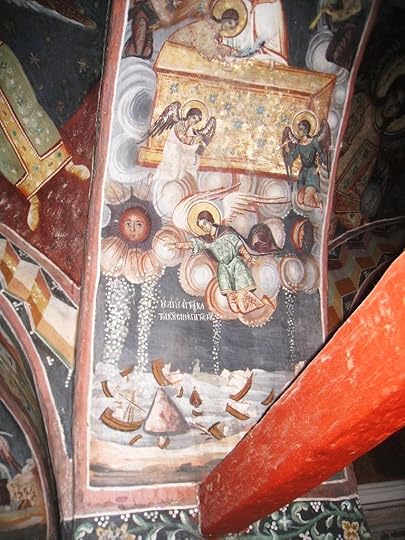 Monastic fresco on Mt. Athos illustrating chapter 8 of the Apocalypse: the angels at the heavenly altar cast judgement/ hail onto the earth and sea.
Monastic fresco on Mt. Athos illustrating chapter 8 of the Apocalypse: the angels at the heavenly altar cast judgement/ hail onto the earth and sea.The first angel blew his trumpet; there came hail… cast upon the earth…. The third angel blew his trumpet and a great star fell from the sky…. The name of the star was Wormwood. (Apocalypse 8:7, 10-11)
The angels begin to blow their seven trumpets and unleash a series of destructive judgements: hail with fire, a flaming mountain thrown into the sea, a falling star. Repeatedly, a third of everything is destroyed: a third of the earth is burnt up, a third of the trees are burnt up, a third of the sea is turned to blood, a third of the sea creatures die, a third of the sun-moon-stars are wiped out, a third of the ships are destroyed (see illustration above). This repetition of the destruction of one-third of everything suggests to many Early Church readers that one-third of the angels rebelled against God and became the demons of hell.
The destructive plagues released by the trumpet blasts mimic the plagues that God sent to destroy Egypt in the book of Exodus. In both cases, creation is undone and refashioned. Many of the prophets in the Old Testament describe similar plague-judgements that God will unleash at the End of Days: the sun and moon and stars will go dark, the sea will be consumed by fire, darkness will envelop the earth. Jeremiah describes a mountain that will be reduced to a burning, smoldering ruin and 1 Enoch describes 7 stars that are like 7 fiery mountains. These are not the acts of a vindictive God; these are the descriptions of what happens when creation rises up in rebellion and goes-against-the-stream that is cooperation (synergy) with God.
One of the most interesting images of judgement-destruction is the star called Wormwood. This name, which in Slavonic is Chernobyl, was often mentioned by evangelical Christians when the Chernobyl nuclear accident happened. It was popular to muse in the United States if the nuclear accident was the great portent of the End described in the Apocalypse; timelines for the coming judgement were eagerly discussed.
Wormwood is a plant with a bitter taste and is a metaphor for divine judgement (Jeremiah, Lamentations, Amos, Proverbs). This plague is the reverse of the miracle at Mara in the desert: there, poison water was made fresh but the star Wormwood makes fresh water poison. “Wormwood” is the perversion of justice in Amos: the blazing star that falls from the sky in the Apocalypse can be viewed as the downfall of the Devil himself, the father of lies and deception (John 8:44).
The post Wormwood appeared first on Stephen Morris, author.
May 4, 2021
The Seventh Seal
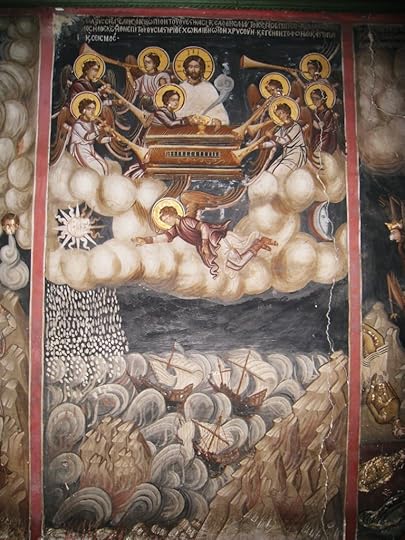 Dionysiou Monastery on Mt. Athos was founded in 1374. In its refectory (dining hall) is a magnificent series of frescoes that illustrate the Apocalypse. In this illustration of chapter 8, we see the seven angels with trumpets, the censer with smoke, a mountain in the sea, the bloody sea water, destroyed ships, the fountain of water, the star Wormwood (in the rocks in the right corner), a darkened sun, etc.
Dionysiou Monastery on Mt. Athos was founded in 1374. In its refectory (dining hall) is a magnificent series of frescoes that illustrate the Apocalypse. In this illustration of chapter 8, we see the seven angels with trumpets, the censer with smoke, a mountain in the sea, the bloody sea water, destroyed ships, the fountain of water, the star Wormwood (in the rocks in the right corner), a darkened sun, etc.When the Lamb broke the seventh seal, there was silence in heaven for about half an hour. I saw the seven angels who stand before God and they were given seven trumpets. (Apoc. 8:1)
The silence in heaven is momentous. It grabs the attention. It is louder than the thunder and commotion that either precede or follow it. Silence is not simply the absence of noise or the lull between events, one thing having finished and the other not yet having started as sometimes happens when a reader or performer is not ready to begin. Silence is a living presence.
I read many years ago that the most brilliant moment in music is the silence before the Et incarnatus of Bach’s “B Minor Mass.” The silence in heaven is like that. It is the sudden silence that follows Dorothy’s house crashing into Munchkinland as it drops from the cyclone in which she has seen Miss Gulch become the Wicked Witch.
This silence in heaven is an echo of the silence in heaven that preceded God’s first utterance: “Let there be light.” (see 4 Ezra 7:30-33) The apocalyptic silence in heaven is liturgical silence, the moment when all creation holds its breath seeing the Word of God crucified. It is the silence of the Great Entrance on Holy Saturday: God the Word has died and descended into Hades. It is the moment before all creation is turned topsy-turvy by Life himself tearing Death to shreds from the inside out.
Before the angels blow their trumpets, another angel-deacon comes to offer incense at the heavenly altar. There is “much incense” offered. The smoke creates an impenetrable cloud, much like the cloud of incense that the prophet Isaiah also saw (Isaiah 6). It was said that when the High Priest offered incense in the Holy of Holies on Yom Kippur that there was not enough smoke if he could still see his hand in front of his face. The smoke creates a buffer that serves to protect the human from the brilliant glory of God that would annihilate anything or anyone that dared stand unprotected in the terrible light.
In the Our Father, we pray, “Thy kingdom come.” Before the kingdom comes, all creation holds its breath and peers through the smoky clouds of incense, waiting to see what will happen when God reveals himself.
The post The Seventh Seal appeared first on Stephen Morris, author.
April 26, 2021
“A great multitude, which no one could number….”

After these things I looked, and behold, a great multitude which no one could number, of all nations, tribes, peoples, and tongues, standing before the throne and before the Lamb, clothed with white robes, with palm branches in their hands…. (Apocalypse 7:9)
The book of the Apocalypse is built on a series of sevens–seven letters, seven seals, seven bowls, seven trumpets, etc. Often there is a pause or intermission between the sixth and seventh event in each series and the seer describes another vision or event that interrupts the series-of-seven. This vision of the great multitude comes as such a pause between the sixth and the seventh seals which the Lamb is opening. This vision of the multitude has two aspects: the seer beholds the 144,000 redeemed from the tribes of Israel and then he beholds the great multitude from all the nations and languages.
The 144,000 is symbolic of all Israel; it is the 12 tribes x 12 apostles x 1,000. It is complete. Full. It is a vast throng of believers, too many to actually count. Modern readers often see the 144,000 as the Jewish-Christian version of the “great multitude” of Gentile-Christians which the seer also beholds. But the original intent of the author was unlikely to distinguish Jewish and Gentile believers. One of the important concerns of the Gospel-Epistles-Apocalypse of St. John is who the authentic heirs of Abraham are; who are the “real Jews” is an issue in all the texts attributed to St. John and the answer is always, “Those who accept Jesus as the Messiah, whether they are biological descendants of Abraham or not, are the true Israel.”
The 144,000 have been marked with the seal of the Lamb–a common description of the anointing with oil/chrism following baptism. Having been sealed with chrism, the 144,000 make their confession, i.e. are slain because they acclaim Jesus as the Messiah. Martyrs for the true faith much as the Maccabees were martyred for refusing to compromise the faith to accommodate with the Greco-Syrian culture prevalent in their society.
The great multitude robed in white with palm branches are also martyrs. (Some readers suggest the 144,000 are the saints on earth and the great multitude are those same saints in heaven.) The palm branches, always indications of victory (1 Maccabees 13:51, 2 Maccabees 10:7), also suggest the feast of Tabernacles (Succoth), which is celebrated in the autumn. Succoth involved processions with palm branches and the building of booths for the people to live in for 8 days (Leviticus 23:33-36, Nehemiah 8:13-18). It was the celebration of God’s care for Israel in the wilderness after the exodus; it was also understood as a celebration which anticipated the Messiah (Zechariah 14:16-19). In both cases, it is God dwelling with his people which is the focus of the celebration.
There are Christian celebrations of Passover-Easter and Shavuot-Pentecost but no Christian equivalent of Succoth; the Church herself is the ongoing feast of Succoth. The Church is the company of those “who shall not hunger or thirst, neither scorching wind nor sun shall smite them, for he who has pity on them will lead them, and by springs of water [he] will guide them” (Isaiah 49:10). It is in the New Jerusalem that Tabernacles is fulfilled, when God will provide “water from the spring of the water of life” (Apoc. 21:6) and wipe away all tears (Apoc. 21:4).
The post “A great multitude, which no one could number….” appeared first on Stephen Morris, author.



